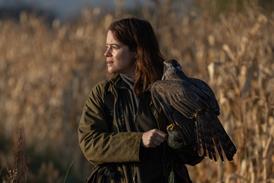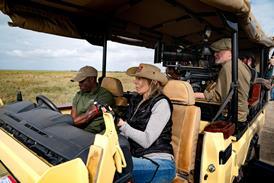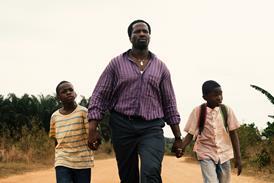In The Breach, Mark Titus examines depleted salmon populations in the Pacific Northwest and what is happening to reverse their decline.
The Breach screened earlier this month at the Palm Springs International Film Festival in California. The Bristol Bay Regional Seafood Development Association is backing a 15-city screening tour across the US, while FilmBuff has recently come on board for distribution.
When did you shoot the movie and how long did it take?
The first spark of an idea for The Breach came to me in April 2011 and we continued shooting necessary bits and pieces through the edit process right up to delivering the cut for our world premiere at the Galway Film Fleadh in Ireland, July 2014.
Who financed and produced it?
My producing partner, Susan LaSalle and I raised the initial funds to begin production through a successful Kickstarter campaign. After that, we were extremely fortunate to have a single investor who believed in our passion for the project come on board to finish the film.
As a lifelong devotee of salmon-fishing you heard about the legendary 100-lb salmon of the Elwha River quite late on and this hooked you into the story of your film. How did you learn about them?
I was on a plane, heading to a commercial shoot in April of 2011, when I ran across a passage in a book I should have read when it was written in 1983 called Mountain In The Clouds by Bruce Brown. It described the construction of a dam in 1913 on the Elwha River in Washington State that effectively wiped out a race of giant King Salmon – 100+ pound Chinooks, fish so big the Lower Elwha Klallam People would think twice before entering the river, for fear of getting smashed between them.
After the dam was built, the salmon were permanently blocked from their spawning grounds. Despite this, these giants would come back to the base of the dam, year after year, slamming their bodies into the concrete, trying to get upriver. It brought to mind the battle cry in Shakespeare’s Henry V: “Once more unto the breach, dear friends, once more…” And the light switch clicked for me: Those dams were scheduled to be breached in September [2011] and I knew a man, Russ Busch – the father of a dear friend, who spent 40 years working to get those dams removed – who was sick with cancer but might just get to see his life’s work realised by seeing those dams breached in the autumn. I had to start filming right away. And that’s what I did.
Why should people see this film?
To me, The Breach is a love story. It expresses my love of this mystical animal that defines the Pacific Northwest, where I’m from. Their self-sacrifice when they return from the ocean to spawn and die and give life to a new generation has been described by many as holy. And the salmon not only give their lives for their own kind, they feed 137 different creatures in the river ecosystems they return to. Including us humans. I think people inherently are drawn to this concept of self-sacrifice for the world to continue in a very profound way. I wanted to create a modern-day poetic fable of sorts that anyone can tap into emotionally – and that seems to be what’s happening with the audiences who have seen The Breach so far.
Summarise the argument in favour of the importance of salmon to communities.
As David James Duncan says in The Breach, for tens of centuries wild salmon fed more people than all the pigs, cattle, wheat – anything we could grow on our own. This was true for a time in Europe and on the East Coast of America and certainly here in the Pacific Northwest where the First People here had one of the most socially and artistically complex societies imaginable – all based on the abundance of salmon as a food source. When wild salmon began to disappear due to overfishing and habitat destruction, communities that had relied on these animals for millennia lost their main food source and spiritual center. Today, if you ask people in the Pacific Northwest if they favour doing what it takes to save the wild salmon we have left, 90% of voters say yes. That’s because we know that wild salmon bring jobs, the healthiest food on the planet, biologically rich nutrients from the sea and a cultural identity to us. The question is whether we have the political will to do what is necessary to back up what we say when we claim to want these fish to remain.
What is the status of the Pebble Mine now and the fight to block it?
The United States Environmental Protection Agency (EPA) spent three years conducting a watershed assessment study on Bristol Bay to try to determine what a mine the size and scope of the proposed Pebble Mine might do to the water, plants, animals and people of Bristol Bay. In early 2014, the EPA released their final findings that a mine of this size and scope would do harm to Bristol Bay, especially noting the impact it could have on the 30-60m sockeye salmon that return there every year. These salmon support people who have survived off them for food and culture for thousands of years, as well as 14,000 jobs that bring $1.5bn to the US economy each year.
So in the summer of 2014, the EPA responded to petitions from tribes, fishermen, and thousands of Alaskans and initiated a process under section 404(c) of the Clean Water Act that would ensure the Pebble Mine is restricted from damaging the Bristol Bay fishery. Northern Dynasty, the Canadian company behind the Pebble Project, sued the EPA in a procedural lawsuit which is still ongoing. As these issues are sorted out in the courts, EPA has been put on hold until at least mid-March. Meanwhile, there are ongoing attempts in both houses of Congress to strip the EPA of their 404(c) Clean Water Act authority as it would apply in Bristol Bay. So, the story about Bristol Bay and whether North America’s largest open pit mine is allowed to damage our the world’s greatest sustainable salmon fishery is far from over.
What is the plan for the film in terms of festivals and distribution?
We were honoured to have the North American premiere of The Breach at the 26th Palm Springs International Film Festival where we were one of the films selected for their “Best of Fest” Award.
As far as other screening opportunities, we’re thrilled to be partnered with the Bristol Bay Regional Seafood Development Association (BBRSDA), who is backing us on a national screening tour in 15 cities across the United States.
Another partnership we’re really excited about is with Vital Choice Seafoods and our master salmon artist in the film, Ray Troll. We teamed up to create a proprietary can of wild Bristol Bay Sockeye Salmon with Ray’s art on the label. Vital Choice Seafoods helped us bring 600 of these cans to the Palm Springs premiere, which we handed out to our very enthusiastic audience after the screenings, each with a password-protected link to the film. We asked the audience to share the link wide if they liked the film — and then we kept that link open for four days only during the festival. In that time, The Breach ended up being watched nearly 1,300 times during that time, for free, and we expanded our army of salmon supporters. It was such a success we will be able to do this at every stop of our 15-city tour.
Finally we’re delighted to announce we have struck a distribution deal with FilmBuff out of New York and are strategising right now when our wide distribution plan will commence.
Is it available digitally?
We expect to be available through video-on-demand platforms worldwide in the spring of 2015. For now, folks can check out our trailer and get up-to-date information on screenings and salmon news by liking our Facebook page.






















No comments yet